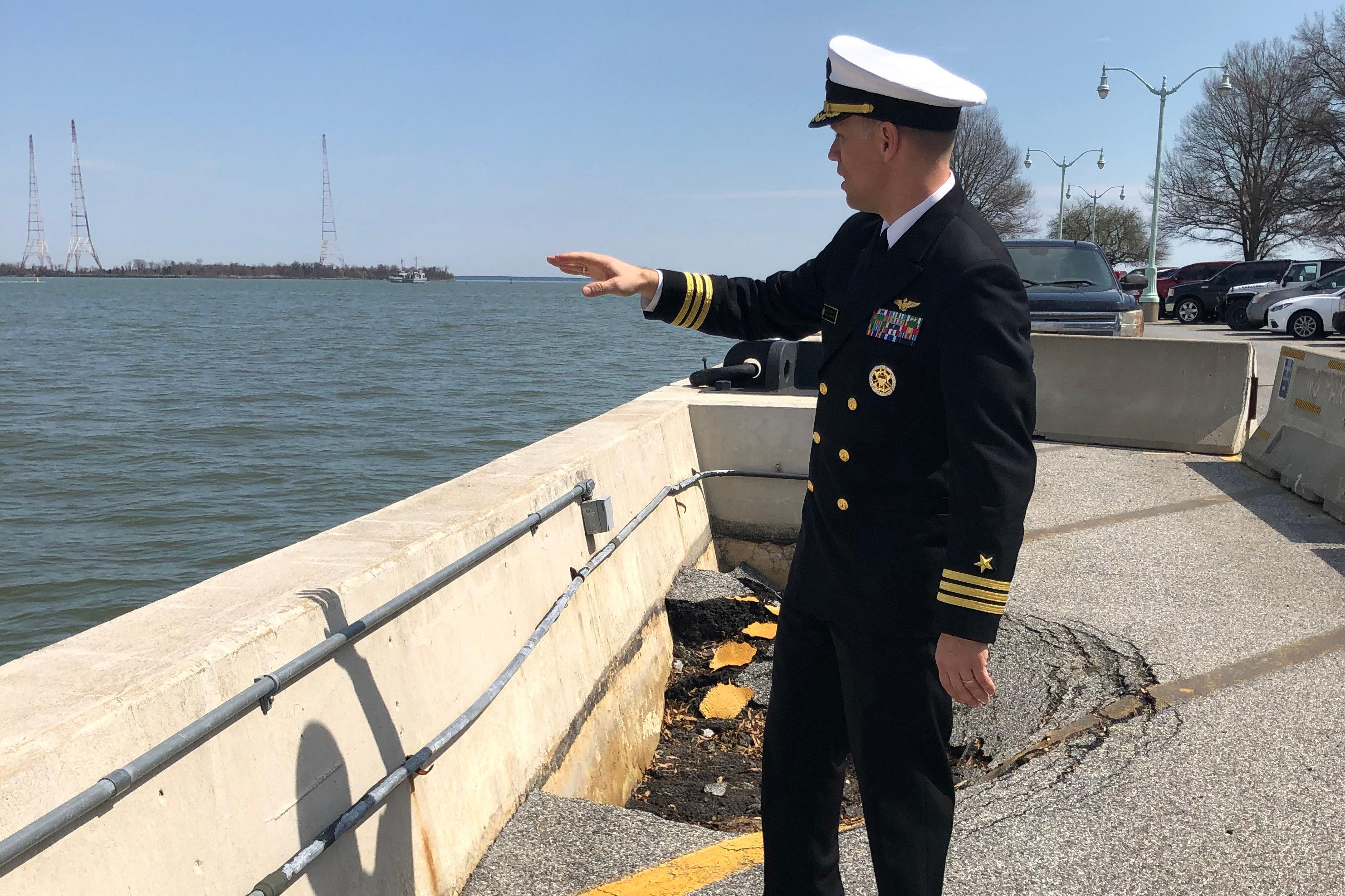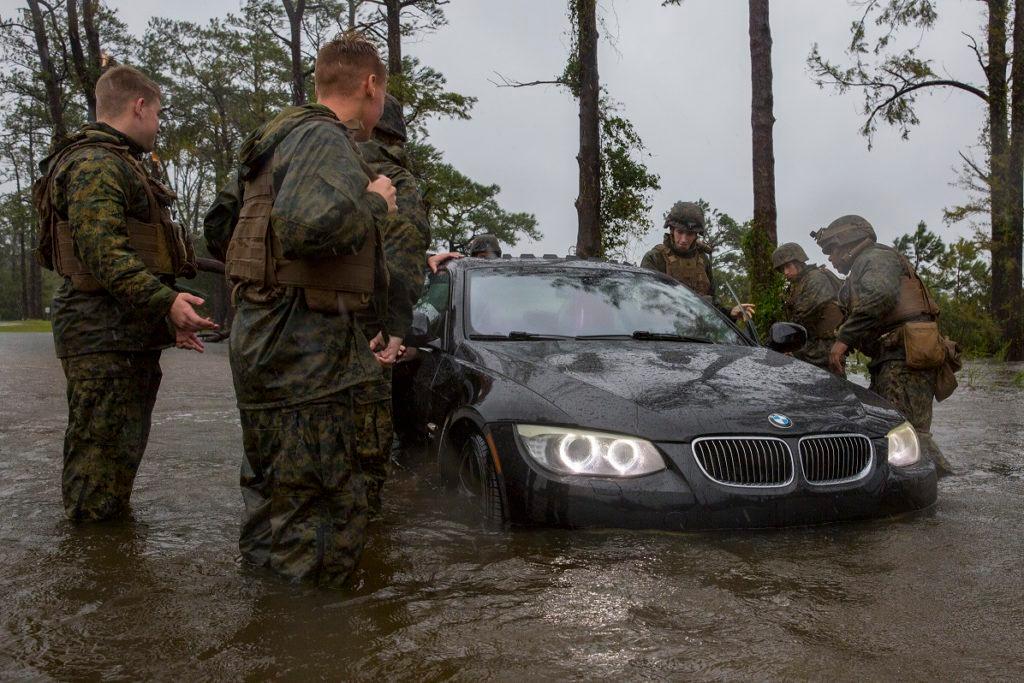
A new government report says many military bases aren't moving fast enough to protect themselves from the effects of climate change and aren't getting proper support from the Pentagon.
The Government Accountability Office looked at a sample of 23 installations and found most hadn't used projections of climate change effects such as sea level rise in their base master plans. That was because they didn't have guidance from the Department of Defense on which projections to use and how to incorporate them.
Experts agree with the GAO report that the Department of Defense hasn't moved quickly enough.
"The DoD is not adequately prepared for this," said Retired Marine Brigadier General Stephen Cheney.
He's chief executive of the American Security Project, a Washington think tank that has been pressing for a more robust military response to climate change.
Cheney said the Department of Defense needs an aggressive plan for shoring up bases that are at risk, especially those on the water.
"It's just going to happen anywhere there's a coastline," he said. "Your coastline's going to erode, you're going to go under water, you're going to have to find a way to get around it."
Cheney knows one of the most threatened bases intimately. He once commanded Parris Island, S.C., the iconic Marine Corp training base for new recruits. It's expected to be exposed to significant flooding in the next few decades. A senior Marine commander told the U.S. Senate Armed Services Committee last year that the base may need a seawall.
Cheney said it would take a lot of wall.
"Parris Island is in trouble," he said, noting that some areas of the base are frequently flooded. "You can't build a sea wall around that entire base. I mean, you're talking miles here."
Cheney said at least Parris Island can be moved somewhere safer, because the training base doesn't have to be on the coast. That's not as easy for bases like Camp Lejeune, N.C. - where the Marines train for amphibious landings - or deepwater ports like Naval Station Norfolk. Cheney says those have to be improved.
The GAO report comes even as the Pentagon is grappling with more than $9 billion in hurricane and flood-related damage to three bases in less than a year.
It says that planners on the bases need more direction from the Pentagon.

"Not assessing risks or using climate projections in installation planning may expose Department of Defense facilities to greater-than-anticipated damage or degradation as a result of extreme weather or climate-related effects," the report said.
One military facility that has already been hit hard by storm-driven flood damage is the U.S. Naval Academy in Annapolis, Md., a city that's dealing with some of the nation's largest increases in sea level-related flooding.
In 2003, Hurricane Isabel flooded buildings on campus, causing more than $100 million in damage.
That was such a big jolt that since then, the Naval Academy has taken some of the most aggressive steps of any military installation to protect itself from the rising water.
On a recent day, Commander David McKinney, a spokesman for the Academy, stood on the waterfront of the Academy's Farragut Field. He was behind a seawall, where two sagging sinkholes had opened in the pavement.
The Academy is planning to rebuild the seawall, but make it higher.
"We haven't been appropriated the funding for it yet, but it'll be happening hopefully in fiscal year 2020," he said. "We're going to take into account that the water level will most likely rise in the future and build it to a higher level, about two and a half feet higher than what it's currently constructed."
The design of the rebuild also will allow even more height to be added if necessary.
There is a lot of flooding in Annapolis, both because of sea level rise and a geological quirk that's causing the land to sink.
"We encounter what we call nuisance flooding quite a bit," McKinney said. "Throughout the campus, where when tides rise, it comes up through some of the drain holes and overfloods the road, and you just have to deal with it."
"This past September that happened over 16 times near our columbarium on the other side of campus," McKinney said. "And it's just a fact of life that we that we deal with now."
Annapolis has about 40 floods a year now, up from fewer than half a dozen just a few decades ago. Most is nuisance flooding that causes little or no damage. But the rising water also makes major storms like Isabel more dangerous.
After the 2003 storm damage, the Academy created an advisory sea level rise committee. In addition to the higher seawall, the Academy also has designed a new building not only to be high enough to avoid flood damage itself, but also to act as a flood control wall to help protect the campus.
Other bases, like Naval Station Norfolk, are taking even more elaborate steps. The world's largest naval base has been working closely for years with a host of partners including the state, federal, and local governments. They're working on projects to protect key roads in the area and conducted a first-of-its-kind land use study focused on the problem.
When the Naval Station builds new structures like barracks and piers, it now builds them higher to cope with the rising water. It's also planning to build new fuel tanks on higher ground because access to the current ones is being cut more frequently by flooding.
Cheney said a big part of the problem is that the Trump Administration has been downplaying the threats posed by climate change.
"It's been difficult to get them to even admit that climate change is causing destruction of major bases and interrupting training worldwide," he said.
But the Pentagon did agree with all the findings in the GAO report. Among other things, it said that it will begin providing bases better guidance on which sea level rise projections to use.
This story was produced by the American Homefront Project, a public media collaboration that reports on American military life and veterans. Funding comes from the Corporation for Public Broadcasting.
Copyright 2019 North Carolina Public Radio – WUNC. To see more, visit North Carolina Public Radio – WUNC.9(MDEyMDcxNjYwMDEzNzc2MTQzNDNiY2I3ZA004))








